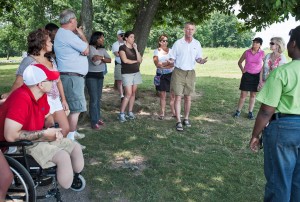
Some moments in life remind you with perfect clarity why you do what you do. During our most recent tour of the Gettysburg Battlefield for wounded warriors, such moments were plentiful.
The day after concluding the “Hancock at Gettysburg” tour, BGES Executive Director Len Riedel and BGES volunteers were ready to repeat the experience – this time with our Yellow Ribbon Fund partners and 25 service members undergoing treatment at Walter Reed Army Medical Center in Bethesda, Maryland.
The troops and 10 family members were ready to go by 8 a.m. so they could take full advantage of the day. Take advantage they did. We noted in a recent post Ed Bearss’ admiration for wounded tour members who never allowed their injuries to keep them on the bus. Just like those he wrote so movingly about, “these troops came.”
As we stood at the center of the Union position on East Cemetery Hill – the object of intense Confederate attacks on July 1, 2, and 3 – Len reminded those gathered on Sunday that this was their land as well, that it was entirely appropriate for a national cemetery to be there to pay lasting tribute to those willing to risk all for kin and country.
Len pointed to the statue of General Winfield Scott Hancock, on horseback, whose extended hand served to steady and calm his troops – a gesture invested in what Len characterized as “leadership most sublime.”

This tour also included Yellow Ribbon Fund board member General Stanley McChrystal (USA, Ret.), former Commander, International Security Assistance Force and Commander, U.S. Forces Afghanistan. We paused to contemplate the State of North Carolina Monument depicting North Carolinian infantrymen advancing during Pickett’s Charge, which would claim heavy casualties from their ranks. General McChrystal noted the statue’s heroic proportions, reflecting the larger-than-life place that our heroes – men and women just like them – have held and will continue to hold in our public consciousness.
The general also noted the strength that great leaders derive from their soldiers. Indeed, he pointed out that General Robert E. Lee’s belief in the capabilities of his soldiers never wavered … that Lee’s plan at Gettysburg was not a forlorn one – the Federals won the battle; Lee didn’t lose it.

Both the lessons of the past and this particular day at Gettysburg made strong impressions on us all. General McChrystal walked and talked with one soldier overcome by emotion by the significance of the three-day battle and of the Civil War, especially for her as an African-American soldier.
Another vivid reminder of why we of BGES choose to understand and preserve America’s history came from the youngest member of the tour. For nearly 45 minutes on the ride home, a 14-year-old young man enthusiastically engaged Len in an intense discussion, revealing his tactical and political understanding of the Civil War. He is today the newest and youngest member of BGES to seek his own membership.
Moments and people like these make us truly grateful for what we do.
(Photos courtesy of BGES member Charles Lee)